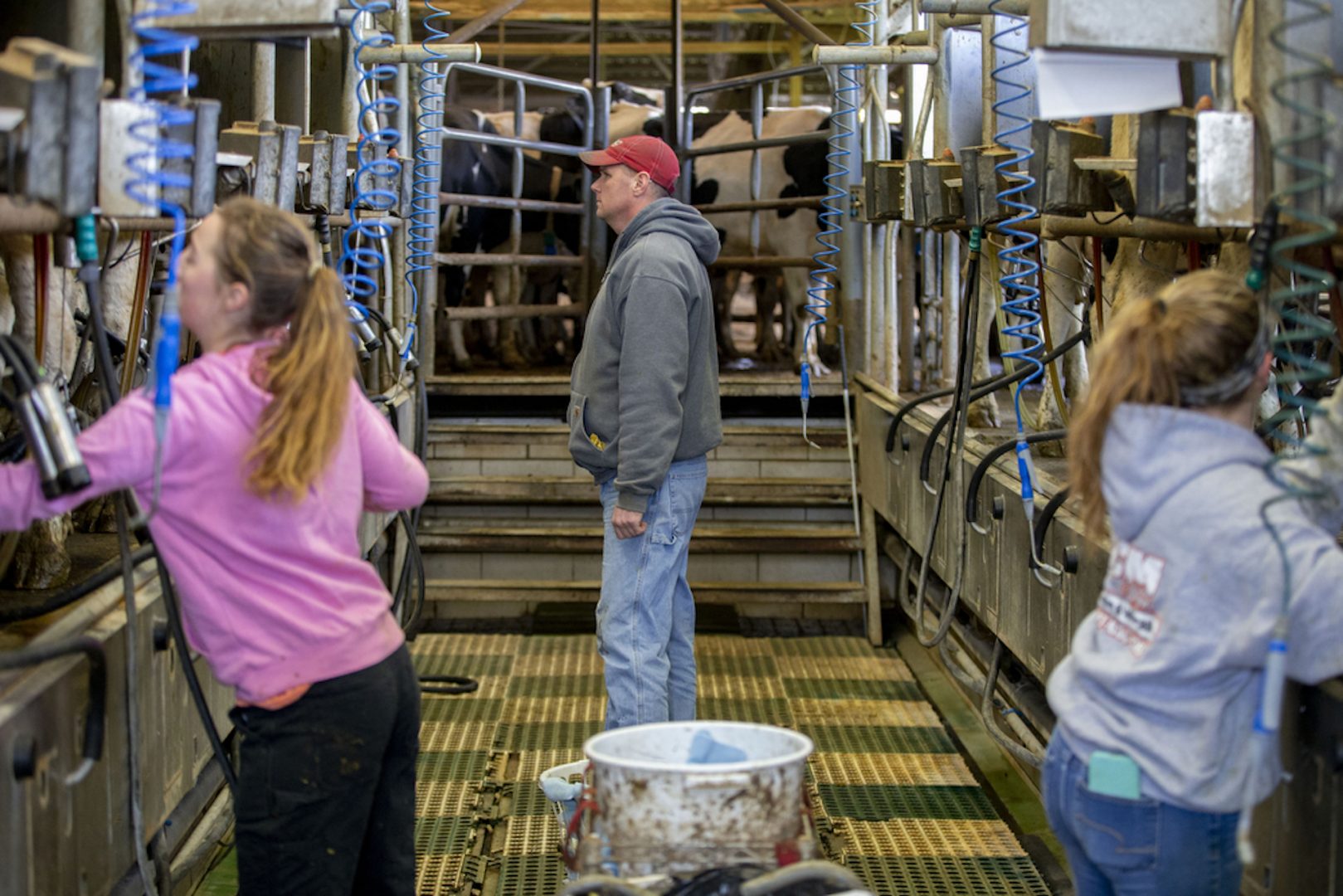
Marrimart Farms owner Donny Bartch and high school students Kiana Stauffer, left, and Summer Bloom attach milking machines to 260 Holstein cows three times a day on the Loysville, Pa., farm on April 11, 2020.
Mark Pynes / PennLive

Marrimart Farms owner Donny Bartch and high school students Kiana Stauffer, left, and Summer Bloom attach milking machines to 260 Holstein cows three times a day on the Loysville, Pa., farm on April 11, 2020.
Mark Pynes / PennLive

Mark Pynes / PennLive
Marrimart Farms owner Donny Bartch and high school students Kiana Stauffer, left, and Summer Bloom attach milking machines to 260 Holstein cows three times a day on the Loysville, Pa., farm on April 11, 2020.
What you should know
» Coronavirus facts & FAQ
» Day-by-day look at coronavirus disease cases in Pa.
» What the governor’s stay-at-home order means
“Maybe that’s what hurts the most — it was nobody’s fault… Now it’s like: ‘Huh. We really can’t win.’”
— Donny Bartch
Perry County farmer
The hits really do just keep coming for Pennsylvania’s dairy farmers.
Just as it looked like they were on the cusp of pulling out of a broad dairy downturn that’s already caused a more than 10% shakeout in the number of working dairy farms across Pennsylvania, the coronavirus pandemic has completely shuttered major market sectors including schools, restaurants and office cafeterias – buyers of one-third or more of many dairies’ milk.
That’s had the effect of upsetting the just-reset supply/demand balance all over again, with expectations that milk prices are headed for the danger zones seen in 2017-18. That’s assuming the farmers are lucky enough to still have a market for their milk.
In an extraordinary step earlier this month, local processor Harrisburg Dairies asked all of its suppliers to dump their milk for two consecutive milking cycles primarily because of the school closures.
“We lost about three states’ worth of school business, and that really rocks the boat for how you manage your product flow,” said Alec Dewey, president of the Harrisburg plant that made headlines in 2018 for rescuing some troubled farms. Schools, Dewey said, constitute about 40% of the dairy’s sales by volume during the academic year.
There has been some growth in grocery and other retail sales in the interim, “but that was a mile away from what we lost in food service,” Dewey said.
In the course of a normal year, in summer months the dairy will scale back supplemental purchases from larger, regional cooperatives, and use sales to other processors like ice cream makers or butter plants to carry through with the farms it has under contract. But there was no way to make those adjustments fast enough last month with the sudden school closures.
“Four days in a row (April 2-5) we dumped milk for all of our farms,” Dewey said. “We haven’t had to do it since, but it’s probably going to be week-to-week until the summer.”
That seemed to be the moment that brought the pandemic’s reality home for Bartch and other farmers around the region. The galling part of is that it happened just as many in the business felt their fortunes were finally beginning to turn.
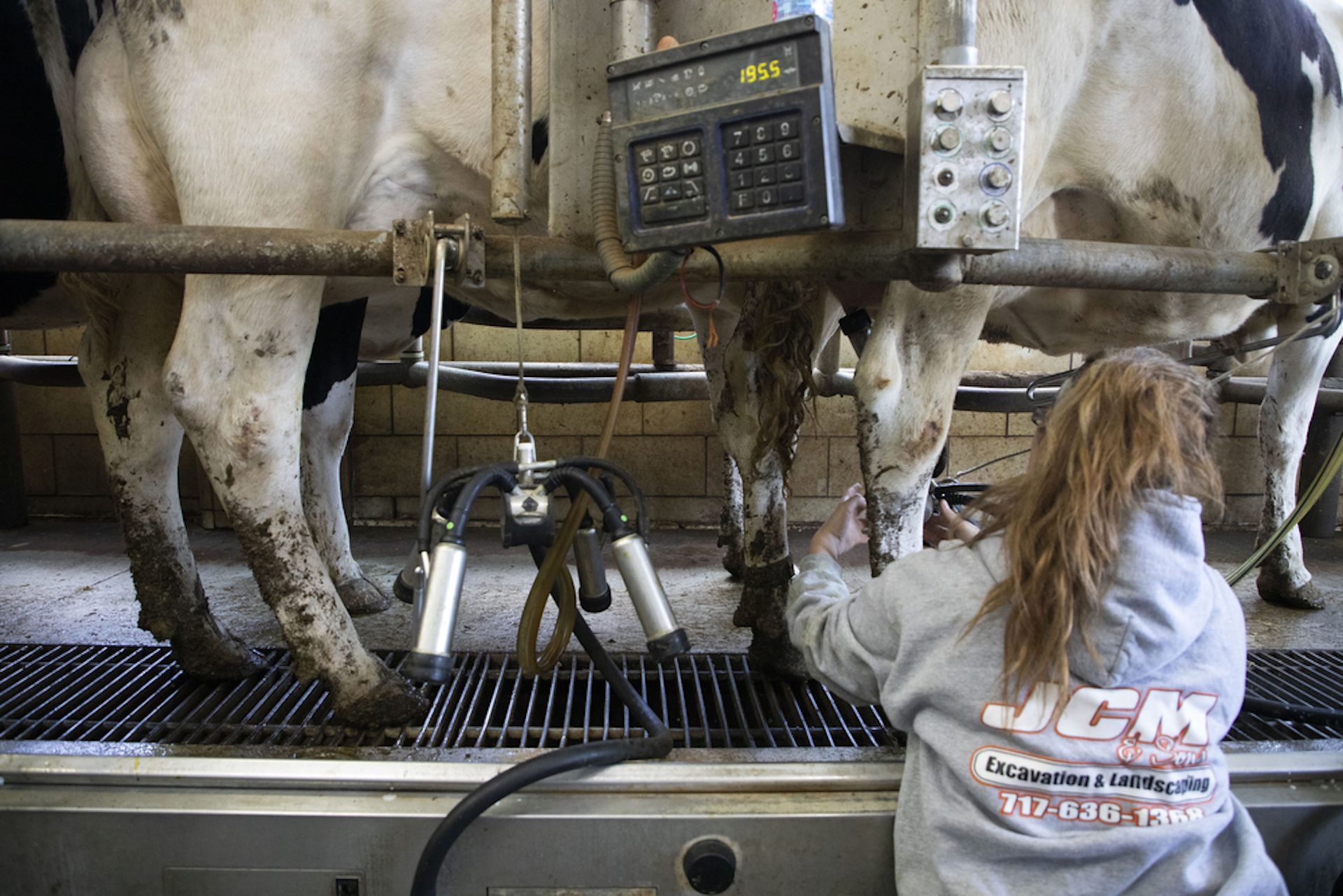
Mark Pynes / PennLive
High School student Sumemr Bloom attaches milking machines to Holstein cows at Marrimart Farms near Loysville, Pa., Apr. 11, 2020.
The industry had already been going through a painful retrenchment in the past few few years. Some 470 dairy farms exited the business in 2019 alone, putting Pennsylvania’s current count of working dairy farms at 5,730. That was after a nearly 20% decline in the number of farms from 2008 through 2018.
But prices had rebounded in late 2019 to above break-even levels, new global export deals had been inked and some farmers were looking to a year in which they could not only catch up from the losses of the past few years, but start to get ahead.
“It looked like 2020 was going to be the first really strong year for dairy farmers in the last five,” said Jayne Sebright, executive director of the Pennsylvania Center for Dairy Excellence.
“Early in the year we saw milk prices ticking up towards $18, $19, $20 dollars per hundred-weight (100 pounds of fluid milk), which is above the cost of production. And then, in about a three-week period when the COVID outbreak started to happen we saw milk price futures for the coming year fall through the floor and they’re actually at the lowest level that they’ve been in the last 10 years.”
Supply is suddenly about 10 percent over demand, by some estimates. “It’s not just school milk sales. It’s the restaurant closures. … It’s the food service institutions that have closed due to COVID-19. We’re really talking about a widespread loss of key markets for dairy,” Sebright said.
And just like that, any near-term prospects of profits seem to have wilted on the vine.
Bartch said that where he was being paid $19 per hundred pounds this winter, May futures put the farmer price back down around $13.
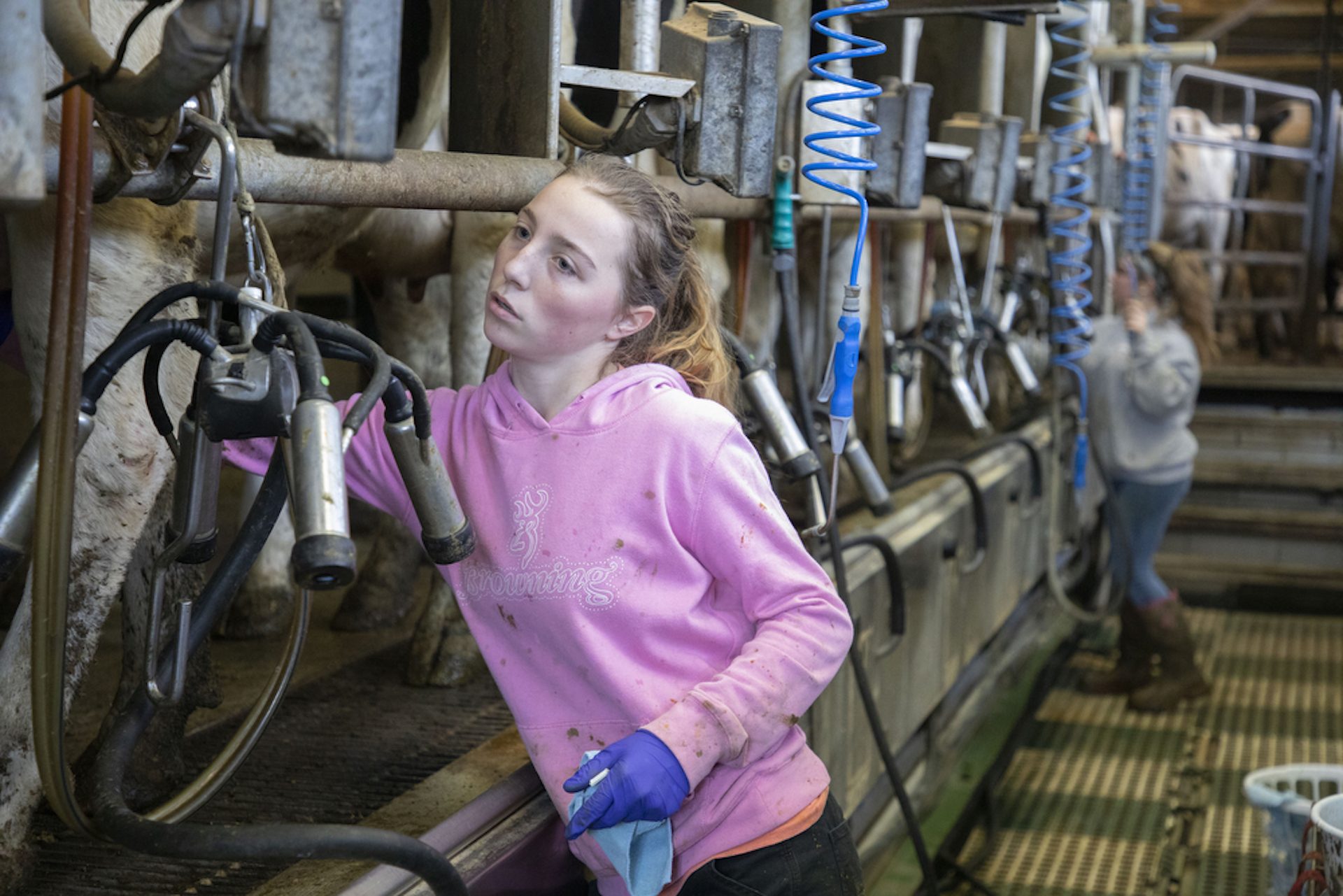
Mark Pynes / PennLive
Marrimart Farms workers Kiana Stauffer, left, and Summer Bloom attach milking machines to 260 Holstein cows three times a day on the Loysville, Pa., farm, Apr. 11, 2020.
Compounding the problem, for some, is that because of the turning tide, many had decided to skip a federal insurance program that guarantees them the cost of production in a bad year. “Hardly anybody signed up for that,” said Cumberland County farmer Steve Nealy who is a member of the Maryland & Virginia Milk Producers Cooperative. “Right now, it’s looking like, man, we should have done that.”
According to the Pennsylvania Department of Agriculture, only 15 percent of Pennsylvania dairy farmers signed up for the Dairy Margin Coverage program.
“We got back in the bottom of the well, and we somehow manage to dig a little deeper,” said Bartch, who at 38 is part of the fourth generation to run his 1,000 acre Merrimart Farms near Loysville in Perry County. His farm made the TV news for all the wrong reasons on April 2, when Bartch, like all Harrisburg Dairies farmers, had to empty his tanks for the first time ever for purely economic reasons.
Harrisburg Dairies wasn’t the only one. Reading-based Clover Farms, a dairy that sells product through eastern Pennsylvania and New Jersey, and the Dairy Farmers of America cooperative have also been forced to ask farmers to dump milk since the outbreak started.
Some other processors, including Dean Foods – the national firm that produces milk through a network of plants that, in Pennsylvania, winds up in stores like Walmart and Giant – and the Maryland & Virginia cooperative, had been able to avoid milk dumps as of Friday, they said.
As painful as the dumping was for the affected farmers, that is actually a far better short-term solution than the alternative, which would be dairies ending their contracts with farms, and forcing them to find new places to take their milk in a depressed market where there just might not be any takers.
“The processor could say: ‘We’re going to cut these farms,’ and then that would be a long-term detriment,” Sebright said.
Industry leaders are also trying to re-route as much fluid milk, butter and cheese as they can into the network that provides charity food distributions through local food pantries.
In both situations, most farmers can at least expect to be paid some lesser price for their products.
But those aren’t likely to be the kind of tools that will help farmers – many of whom are already in super-vulnerable financial situations because of the recent “dairy depression” – ride out this storm for anything close to its expected duration.
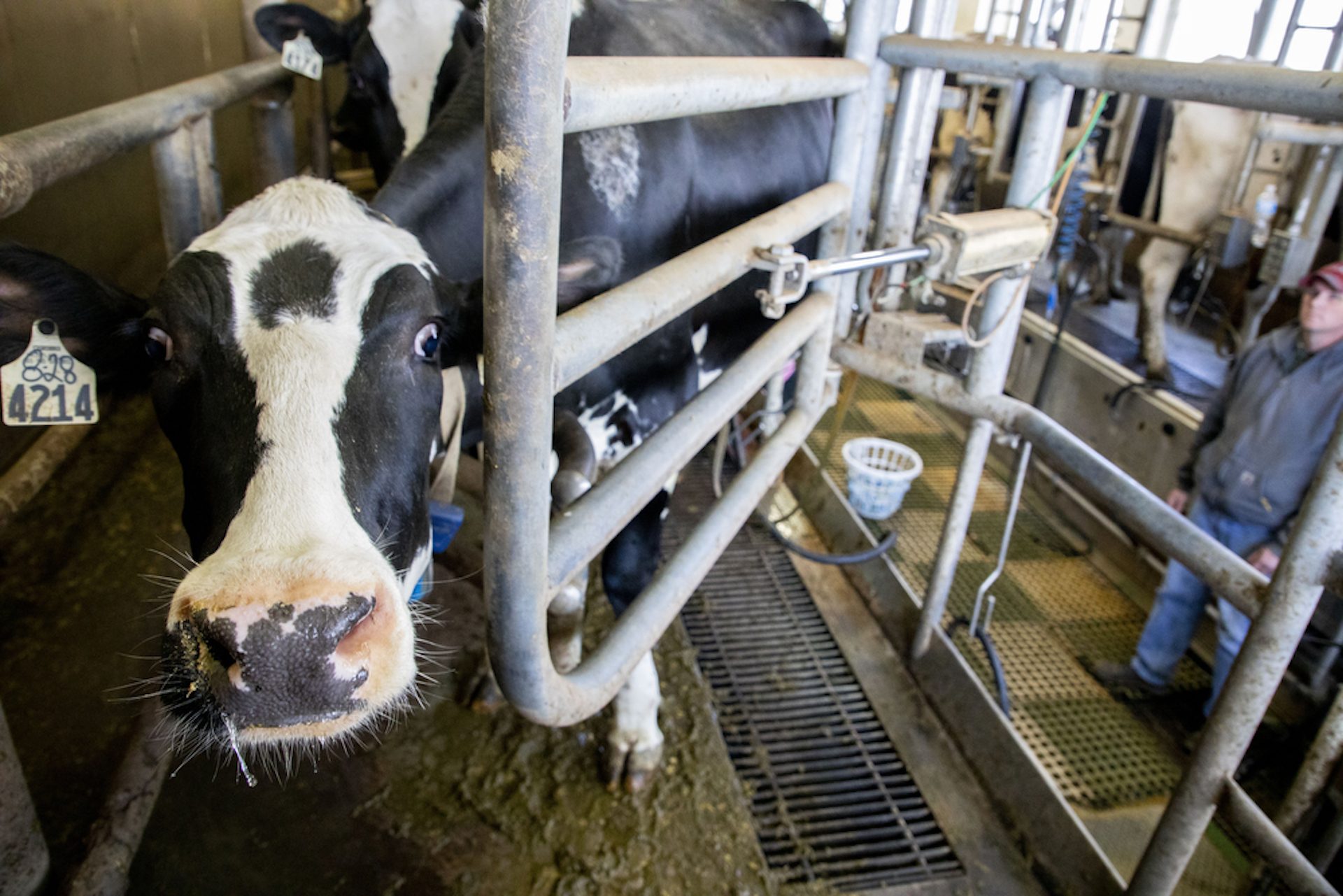
Mark Pynes / PennLive
Marrimart Farms, owned by Donny Bartch, has 260 Holstein cows that are milked three times a day on the Loysville, Pa., farm, Apr. 11, 2020.
They will need to be supplemented, farm industry advocates and policy makers say, with some combination of other steps like paying farmers who cut milk production by 10% from their March baselines an extra subsidy for the rest of their milk; forgivable loans to dairies that keep buying from their current farms, similar to the new paycheck protection program aimed at covering payroll for small businesses.
Those two measures were called for last week by two major dairy trade associations: the National Milk Producers Federation and the International Dairy Food Association.
Others have called for measures like a period of forbearance on farm debt obligations; or a reopening of windows for farmers to get production cost insurance.
“This is a national crisis that requires a national response,” state Agriculture Secretary Russ Redding told PennLive in a recent telephone interview.
And the key is building a bridge that will help farmers — who are by definition in a business that’s built for the long-term — over the current crisis.
“Dairy can’t just turn off cows. It can’t just close dairy farms and expect them to reopen in two months. It doesn’t work like that,” Sebright said.
She and Redding both argue the fundamentals for Pennsylvania as a dairy state remain strong: It’s close to the massive Eastern Seaboard population centers; there’s a critical mass of farms (5,730 entering this year) to support the needed support businesses; and there’s still a good core of dairies and other processors.
“As soon as the channel opens to do any type of food service I think the market will respond immediately,” Redding said. “This is not a fundamental flaw inside of the marketing plan. It’s an interruption to the marketing plan, and that’s where I take sort of the hope and optimism … that as soon as we get some new normalcy around this marketplace, people will want to eat dairy.
“We just have to struggle through this period, particularly to get the food service side back in some form” and, in the interim, try to prevent another cohort of farmers from making immediate decisions that have generational consequences, Redding said.
That’s going to require all parties cooperation: the federal government pushing immediate cash into the system through the rescue; farmers being smart about their production levels, deferring maintenance and other costs; and communications from cooperatives and other processors to the farmers about market expectations.
“It’s chaotic. Everyone’s looking for certainty at a time you can’t give them any. It just makes it really difficult if you’re in a business where it’s not just about today and this season and the year. It’s about a generation. And that’s what I worry about it,” the Agriculture Secretary continued. “It’s a generational decision that people are going to make today about: ‘Can I stay here? Should I stay here?’
“So the stress level on farms, it was high before, it’s overwhelming now to find some peace of mind in this storm.”
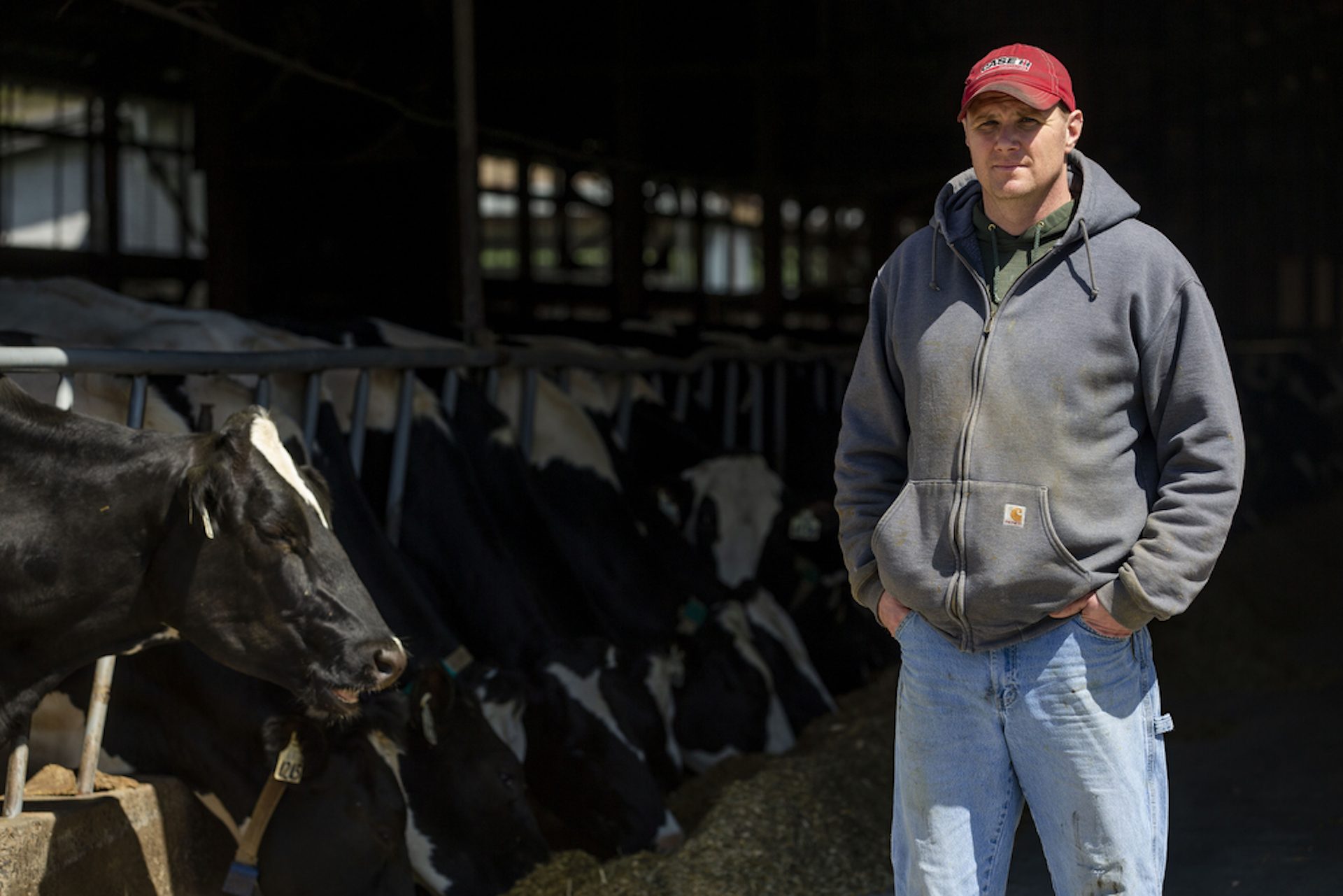
Mark Pynes / PennLive
Donny Bartch, owner of Marrimart Farms, has 260 Holstein cows on his Loysville, Pa., family farm, Apr. 11, 2020.
Bartch is among many family farmers who have applied to the U.S. Small Business Administration’s Paycheck Protection Program for a potentially forgivable loan to cover short-term costs, and he’s also exploring the early sale of some Merrimart’s beef herd to other livestock producers. The farm employs the equivalent of about 9 full-time employees.
One thing he is not doing?
Giving up.
The farm is engaged in its normal spring planting, and continuing to milk the herd as usual.
“It’s trying to buy time,” he explained in an interview last week.
“The economy I do believe is still strong when we get get up and rolling again. We’ve been through tough times before. We kind of know how to put our noses to the grindstone and we’re going to try to grind it out here,” Bartch said. “But how long can we last at this kind of pace? There’s a certain level here where it’s just like we’re going to have to wait and see.”
PennLive and The Patriot-News are partners with PA Post.
The days of journalism’s one-way street of simply producing stories for the public have long been over. Now, it’s time to find better ways to interact with you and ensure we meet your high standards of what a credible media organization should be.